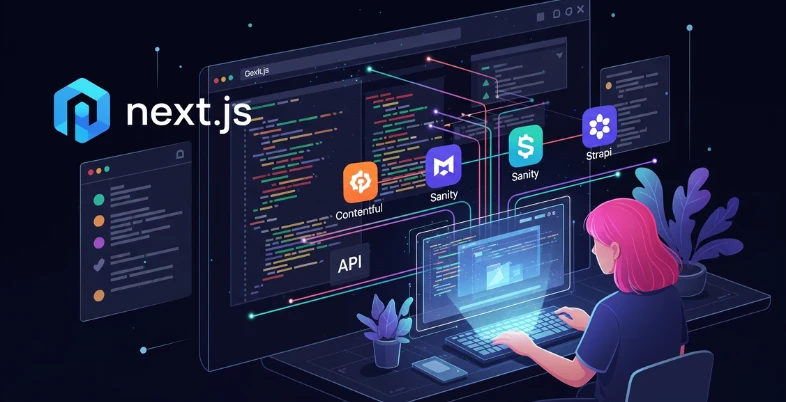In 2025, building a fast, SEO-friendly website with Next.js is more popular than ever. Did you know that over 50% of React developers now use Next.js to power modern sites and apps? At the same time, the headless CMS market is growing fast — it’s expected to reach $2.2 billion by 2027, as more businesses switch to flexible, API-first content solutions.
With so many CMS options out there, picking the best one can be tricky. That’s why we’ve made this list of the Top 15 Best CMS for Next.js in 2025 — so you can find the right fit for fast, scalable, and easy-to-manage websites.
Key Things to Consider When Choosing a CMS for Next.js
- API Flexibility: Make sure the CMS supports REST, GraphQL, or both, so it works smoothly with Next.js static and dynamic pages.
- Ease of Use for Editors: A user-friendly dashboard and visual editing help non-developers manage content without needing constant dev help.
- Performance & CDN: A CMS with a strong CDN ensures your site loads fast worldwide, which is crucial for SEO and user experience.
- Custom Content Models: Look for tools that let you create reusable content blocks or slices that align with your Next.js components.
- Pricing & Scalability: Check if the CMS has a free tier, pay-as-you-grow plans, and features that can handle your traffic as you scale up.
Benefits of Using a Headless CMS with Next.js
- Faster Websites: Headless CMSs and Next.js help you build static pages that load quickly, improving SEO and conversions.
- Omnichannel Delivery: You can reuse the same content across websites, mobile apps, and other digital products
- Better Developer Experience: APIs and starter kits make it easy to fetch content exactly when and how you need it.
- Flexible Workflows: Editors and developers can work in parallel — developers build the frontend, while editors manage content independently.
- Future-Proof Stack: Headless CMSs don’t lock you in — you can change your frontend or framework anytime without migrating your content.
List of Top 15 CMSs for Next.js in 2025
1. Contentful
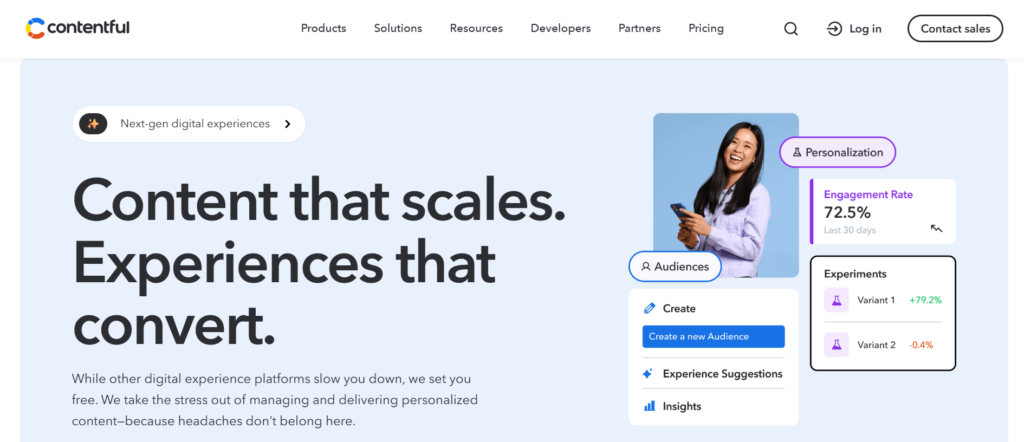
Website: https://www.contentful.com/
Contentful has for many years been an early developer favorite when building new web applications with Next.js and the likes. It is a headless CMS with extensive APIs and a content modelling of content that enables you to organize your content the way you desire. Contentful enables you to manage the content on multiple digital products and channels in a single hub, which makes it particularly attractive to teams that have to work on more challenging or large-scale projects. It has a performant and healthy content delivery network to make your Next.js websites fast across the globe.
The Contentful feature that makes it appealing to the Next.js developers is a large set of GraphQL and RESTful APIs and an available set of SDKs (JavaScript). This implies its ability to pull content at build time in order to perform static generation or at runtime to do the server-side rendering, which perfectly coincides with the flexibility presented by Next.js. Its editing process is user-friendly to the non-technical teams as well, and so the developers and the content editors are able to operate without any bottleneck.
Top Features:
- Highly customizable content models
- Rich GraphQL and REST APIs
- CDN-backed global delivery
- Roles and permissions for teams
- Robust integration marketplace
Pricing:
| Free | Lite | Premium |
| $0 | $300/mo | Available on request |
2. Sanity
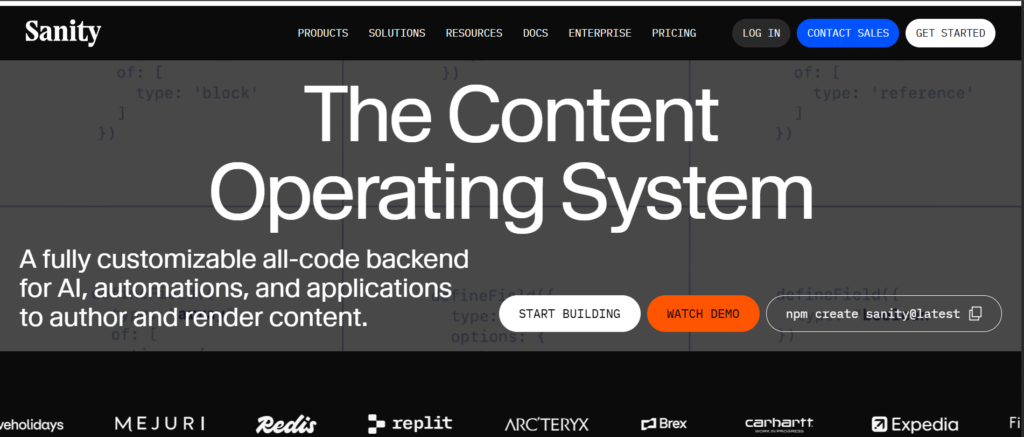
Website: https://www.sanity.io/
One more powerhouse headless CMS is Sanity, which perfectly fits with Next.js. The most impressive is the Real-time Content Studio, an open, customizable, and flexible editing platform that can be tailored in regards to your content requirements entirely. Sanity offers a contemporary method to content management as its contents are structured and, therefore, providing omnichannel experiences is simple. Its versioning capabilities and real-time collaboration capabilities enable a large team to maintain the content current and consistent, even when the team is separated by time zones.
Sanity has a developer-first toolset that is valued by its developers. Its formidable GROQ query language and customizable APIs can help you to get exactly the piece of content you want, at the time you want it. To Next.js users, Sanity is also very attractive since it natively integrates with the incremental static regeneration and the server-side rendering workflow. Also, the ample free offerings and pay-as-you-go pricing model make it appropriate in startups as well as businesses.
Top Features:
- Customizable, open-source content studio
- Real-time collaboration and live preview
- GROQ query language
- CDN-backed global delivery
- Excellent developer tooling and plugins
Pricing:
| Free | Growth | Enterprise |
| $0 | $15/mo | Custom |
3. Strapi

Website: https://strapi.io/
Another open-source headless CMS is Strapi, which stands out for its adaptability and thriving developer community. Strapi is developed using JavaScript and is simple to extend and customize, so it suits a developer who wants complete control over their content API. In the case of Next.js apps, Strapi offers a smooth method of presenting dynamic material using REST or GraphQL API. Strapi can be installed on your server or in Strapi Cloud to have easier hosting.
The biggest advantage of Strapi is its plugin ecosystem and customizable administrator panel. You will be able to categorize your content visually and add more functionality through a plugin or customized programming. Its role-based access control and user management are simple, which is a good option in projects involving different team members with diverse access requirements. Be it a simple blog setup or a complicated multi-language site with Next.js, Strapi can help you scale according to your needs.
Top Features:
- Open-source and self-hostable
- REST and GraphQL API support
- Visual content-type builder
- Role-based access control
- Large community and plugin ecosystem
Pricing:
| Community | Growth | Enterprise |
| $0 | $15/mo | Available on request |
4. Storyblok
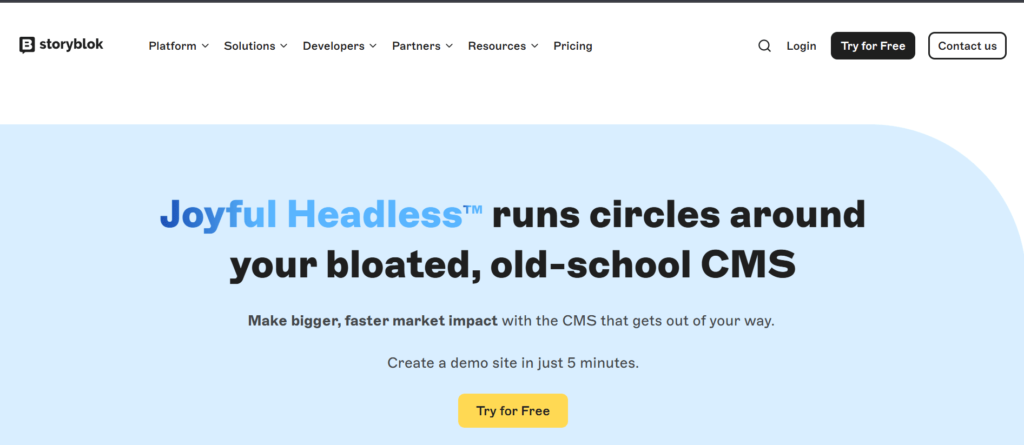
Website: https://www.storyblok.com/
Storyblok aims to enable developers and content editors to work with a headless CMS. It has a special visual editor, which can give non-technical users a real-time preview of the changes they are making, and this is very beneficial to the collaboration between marketing and development teams. Storyblok offers strong APIs and SDKs that help the developers of Next.js to integrate the workflows of dynamic or static content without much trouble. Its method assists in providing quick sites that are scalable all over.
The most interesting feature of Storyblok is the component-driven content approach, which is precisely what Next.js has in mind to create components. You can create reusable blocks of content that can be directly related to the Next.js components, and your content structure will be synonymous with your codebase. This simplifies the work on updating the content. Being a multi-language supported and multi-content workflow system, Storyblok is an excellent choice in terms of international brands too.
Top Features:
- Visual editor with live preview
- Component-based content structure
- Multi-language support
- Flexible API for static and dynamic sites
- Powerful asset management
Pricing:
| Growth | Growth+ | Premium |
| $99/mo | $349/mo | Custom |
5. Hygraph
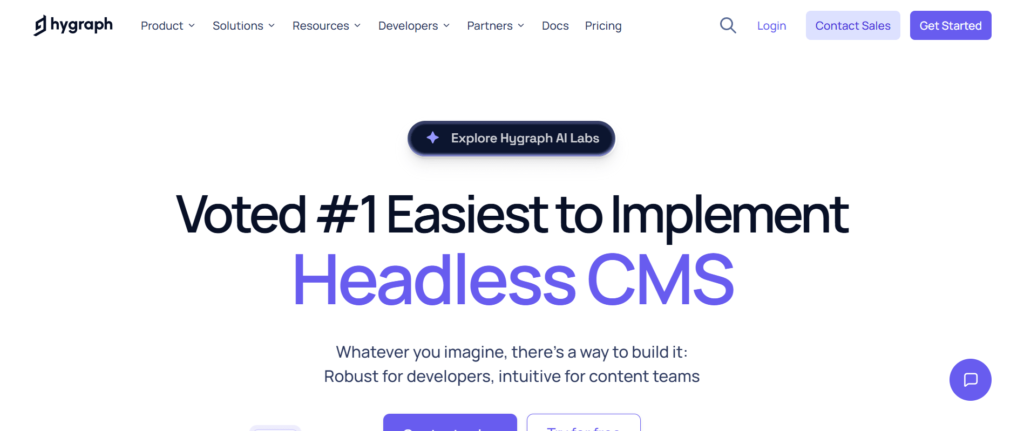
Website: https://hygraph.com/
Hygraph is a leading headless CMS that leans heavily into GraphQL, making it a strong match for modern frameworks like Next.js. It allows developers to build highly performant websites with dynamic content using GraphQL queries, which are efficient and easy to manage. Hygraph’s user-friendly interface lets editors create and manage structured content without needing technical skills, so developers can focus on building instead of managing content updates.
Hygraph’s native GraphQL API, server-side rendering, and support for static site generation make it an excellent choice for Next.js. It also offers advanced content federation capabilities, letting you bring data from multiple sources into a single API. This is incredibly useful for large projects where you may be combining e-commerce, marketing, and user-generated content. With powerful localization features and a generous free tier, Hygraph works for startups and enterprise teams alike.
Top Features:
- GraphQL-native CMS
- Powerful content federation
- Excellent localization and multi-language tools
- Role-based permissions and workflows
- Supports static and dynamic rendering
Pricing:
| Hobby | Growth | Enterprise |
| $0 | $299/mo | Custom |
6. Prismic
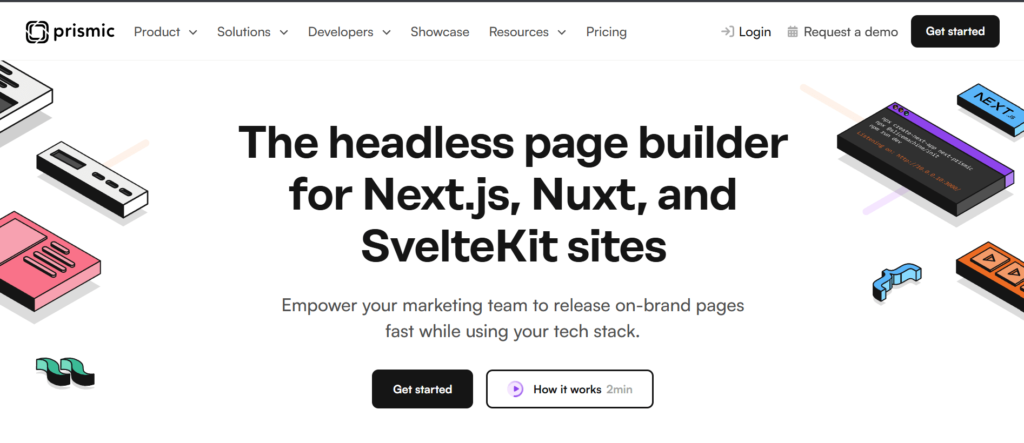
Website: https://prismic.io/
Prismic is a popular headless CMS designed to help teams ship modern websites faster, and it’s a favorite for Next.js developers thanks to its flexible content slices and visual editing. Prismic’s Slice Machine is especially powerful because it lets developers and content teams work together to create reusable content sections. These slices directly map to React or Next.js components, making site updates easier and keeping the codebase clean and maintainable.
Additionally, Prismic has a powerful preview capability that integrates easily with server-side rendering and static generation in Next.js. Editors can see exactly what a page will look like before publishing, minimizing mistakes and back-and-forth. Its built-in scheduling, multi-language support, and straightforward API help teams deliver high-performance, content-rich sites faster, whether you’re building a simple blog or a complex marketing site.
Top Features:
- Slice Machine for reusable content blocks
- Visual preview and publishing workflows
- RESTful and GraphQL API
- Multi-language and localization tools
- Integration with static and dynamic Next.js builds
Pricing:
| Free | Medium | Platinum | Enterprise |
| $0/mo | $150/mo | $675/mo | Custom |
7. ButterCMS
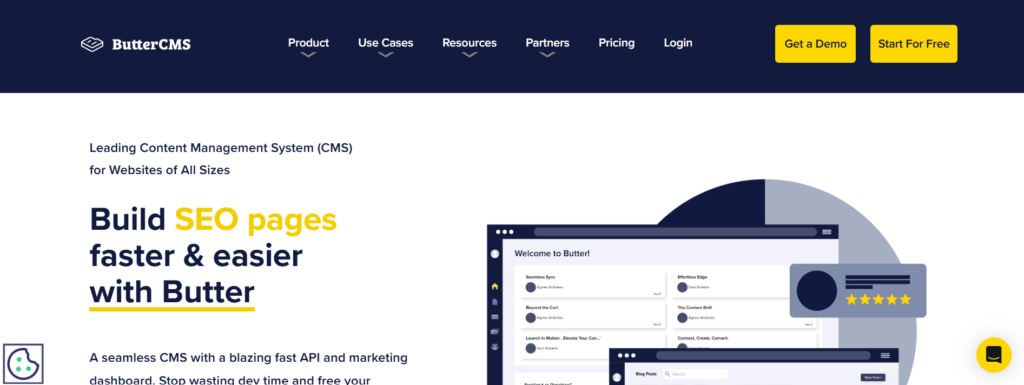
Website: https://buttercms.com/
ButterCMS targets developers who need to integrate a CMS with any technology stack in a fast manner due to its low weight, quick configuration, and ideal compatibility with Next.js. Instead of being largely configurative like certain CMSs, ButterCMS is prepared with powerful APIs, an easy-to-comprehend dashboard, and formidable documentation. That way, your Next.js project may be hooked up to ButterCMS, and you may go to work managing content within minutes, not days.
People often admit that ButterCMS has an integrated blog engine, site modeling, and built-in multi-site features, making it one of the preferred SaaS websites, e-commerce companies, and marketing agencies. With Next.js, you can use ButterCMS APIs to pre-load content during the build or render it dynamically at runtime, based on the performance requirements you have. Its SEO-friendliness, media library, and content scheduling ease of use are loved by the marketing teams since they streamline marketing workflow.
Top Features:
- Easy integration with Next.js
- Powerful blogging capabilities
- Flexible content modeling
- SEO tools and media management
- Multi-site and multi-language support
Pricing:
| Micro | Startup | Small Business | Enterprise |
| $99/mo | $199/mo | $375/mo | Available on request |
8. Netlify CMS
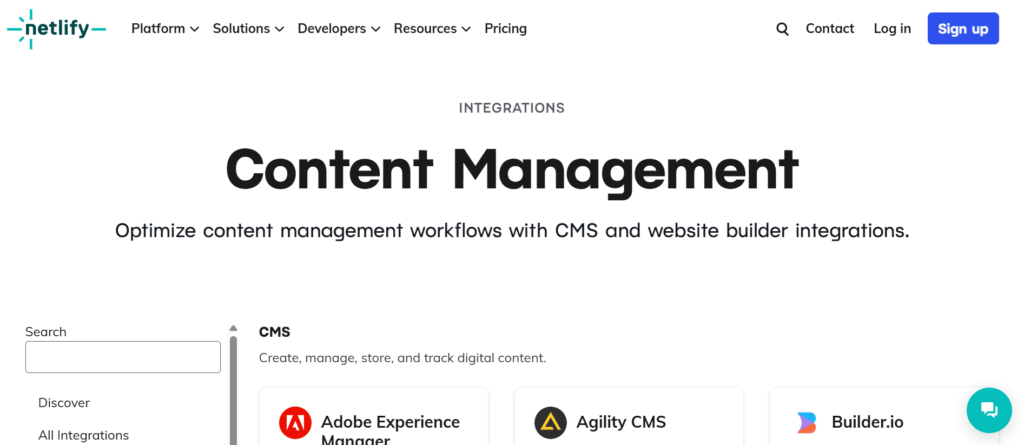
Website: https://www.netlify.com/integrations/content-management/
Netlify CMS is an open-source, free CMS that is especially successful with developers who prefer working with Git. Unlike most headless CMSs, which require an additional external API, Netlify CMS grants you direct access to your content in your Git such as it is. This implies that your content would be side by side with your code, which integrates well with Next.js static sites and makes sure to have version control over all your changes to content.
When you have Netlify CMS, editors exploit a basic web interface to update the information, which is then treated as a pull request to submit the changes in your Git repository. This brings the developers complete visibility and control of what goes live and at what time. It is a dream combo when it comes to Next.js projects: you will have a fast static build, content versioning, and can easily roll back the change. By the way, it is open-source, so you could expand it or adjust it to your specific needs in your project.
Top Features:
- Git-based content management
- Open-source and customizable
- Seamless version control and rollbacks
- Simple content editing UI
- Perfect for static site generation
Pricing:
| Free | Pro | Enterprise |
| $0 | $19/mo | Custom |
9. Ghost
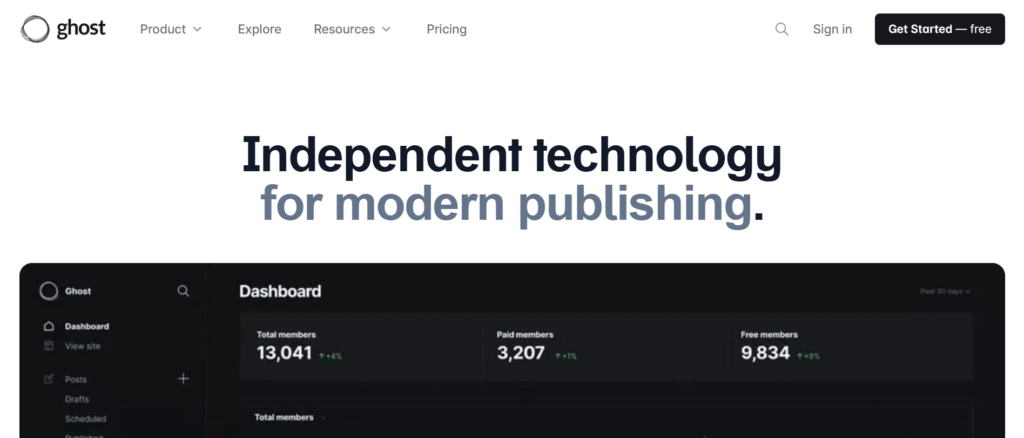
Website: https://ghost.org/
Ghost started as a modern blogging platform, but it has evolved into a robust, API-driven CMS that pairs beautifully with Next.js for publishing high-performance content sites. Ghost’s core strength is its simplicity and performance — you can use its built-in themes or treat it purely as a headless CMS to power your Next.js frontend. This flexibility makes Ghost popular among independent publishers, startups, and even large media brands.
For developers, Ghost provides a well-documented REST API and Admin API, so you can pull content into your Next.js site easily. It also supports powerful membership and subscription features out of the box, which is a big plus if you’re building paid content or newsletters. Ghost’s rich editor, built-in SEO, and fast performance mean you can focus on growing an audience without worrying about heavy plugins or bloated code. With the growing use of AI content writing tools, Ghost fits well into modern publishing workflows by supporting automation, efficiency, and seamless content management.
Top Features:
- Simple yet powerful headless API
- Memberships and paid subscriptions
- Fast and lightweight performance
- Built-in SEO and AMP support
- Easy to self-host or use Ghost(Pro)
Pricing:
| Starter | Creator | Team | Business |
| $9/mo | $25/mo | $50/mo | $199/mo |
10. Cosmic
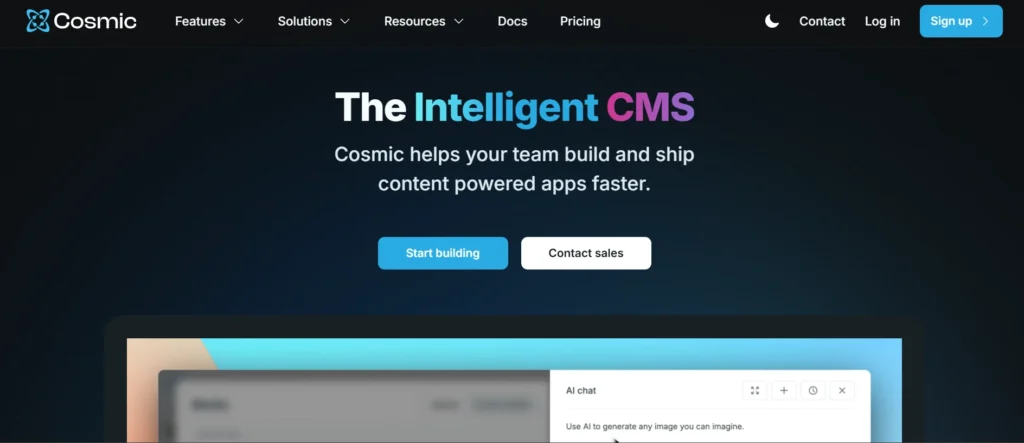
Website: https://www.cosmicjs.com/
Cosmic is a new generation headless CMS that emphasizes speed and developer-friendly content management. Its API-first style and compatibility sync well with Next.js regardless of the type of site or application you want to create: static, server-rendered, or a hybrid. The dashboard of Cosmic is intuitive yet effective, which allows you to formulate content models, assets, and interact with your fellow teammates in real-time.
The worldwide CDN, the webhooks, and easy GraphQL or REST API access provided by Cosmic will enable you to create Next.js applications that are both lightning-fast and scalable. It is very convenient to start with: no difficult settings, SDKs, and starter templates help to launch the work at a high speed. Whether you are building a marketing site, product catalog or blog, Cosmic makes your workflow developer-friendly, fast, and ensures your site remains performant.
Top Features:
- Intuitive API-first content management
- REST and GraphQL API
- Real-time collaboration tools
- Built-in CDN and webhooks
- Easy-to-use starter templates and SDKs
Pricing:
| Free | Starter | Pro |
| $0 | $299/mo | $499/mo |
11. DatoCMS
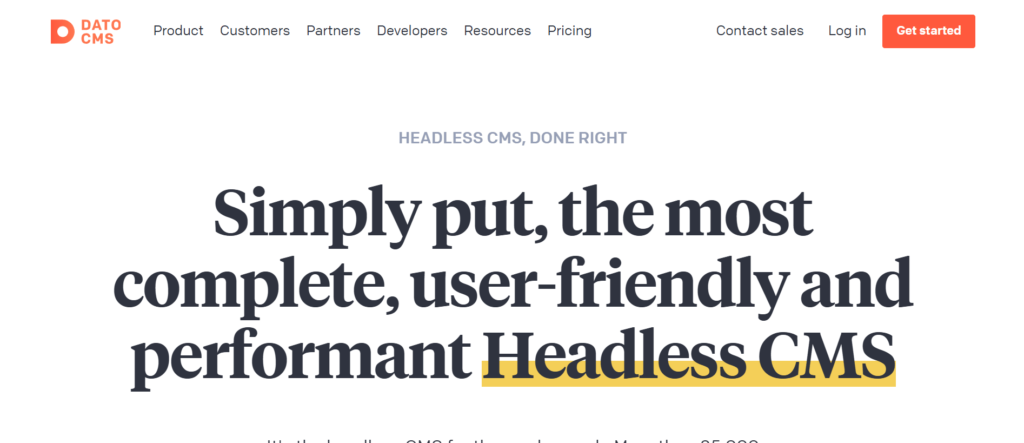
Website: https://www.datocms.com/
DatoCMS is a powerful headless CMS that has gained a loyal following among Next.js developers for its performance and developer-friendly features. It’s designed to help teams build highly performant websites and apps with dynamic content while keeping workflows simple for editors. With DatoCMS, you can manage structured content, images, and SEO metadata all in one place, and its global CDN ensures content is delivered fast, wherever your users are.
What really sets DatoCMS apart is its seamless integration with static site generators like Next.js. It supports static site generation, server-side rendering, and incremental static regeneration (ISR) — which makes it easy to deliver fast-loading pages that can be updated on the fly. Its GraphQL Content API is highly efficient and flexible, letting you fetch only what you need. For teams, the intuitive interface, localization support, and real-time previews make content editing and publishing effortless.
Top Features:
- Blazing-fast GraphQL API
- CDN-backed global content delivery
- Supports static and dynamic rendering
- Intuitive editor interface with live preview
- Advanced localization and SEO management
Pricing:
| Professional | Enterprise |
| $149/mo | Custom |
Also Read: CMS for Jamstack
12. Agility CMS
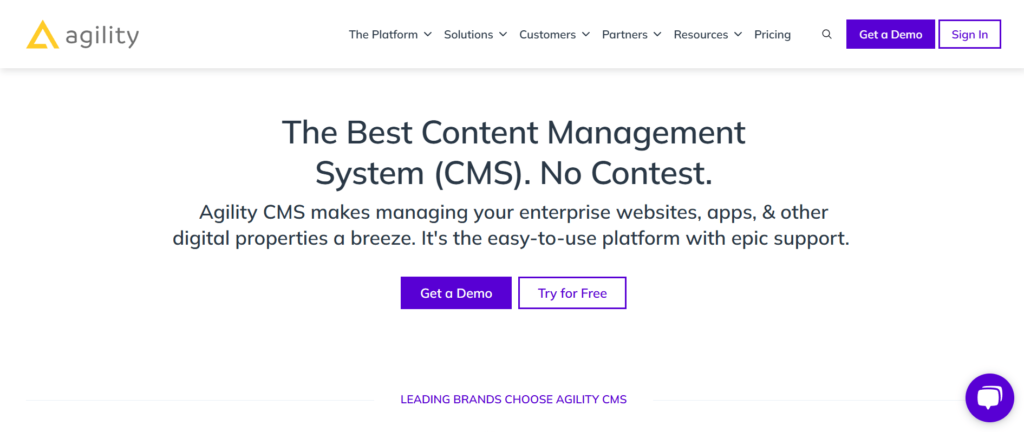
Website: https://agilitycms.com/
Agility CMS brands itself as a “headless CMS with Page Management,” which makes it a standout choice for Next.js developers who want a balance between flexible APIs and an editor-friendly experience. Unlike purely headless options that can overwhelm non-technical teams, Agility CMS provides visual sitemaps, page management, and easy content modeling, so content editors have more control without needing constant developer input.
Agility CMS provides webhook support, Next.js starter templates, and quick REST and GraphQL APIs for developers to get started right away. You can build fully static, dynamic, or hybrid sites depending on your performance goals. Agility’s multi-site and localization capabilities make it suitable for brands managing content across regions or languages. Combined with its robust support and modern dashboard, it’s a flexible CMS for small teams and enterprises alike.
Top Features:
- Visual page and sitemap management
- REST and GraphQL APIs
- Multi-site and multi-language support
- Built-in content scheduling
- Starter kits for Next.js projects
Pricing:
| Free | Starter | Pro | Enterprise |
| $0 | $1249/mo | $2499/mo | Available on request |
13. TinaCMS
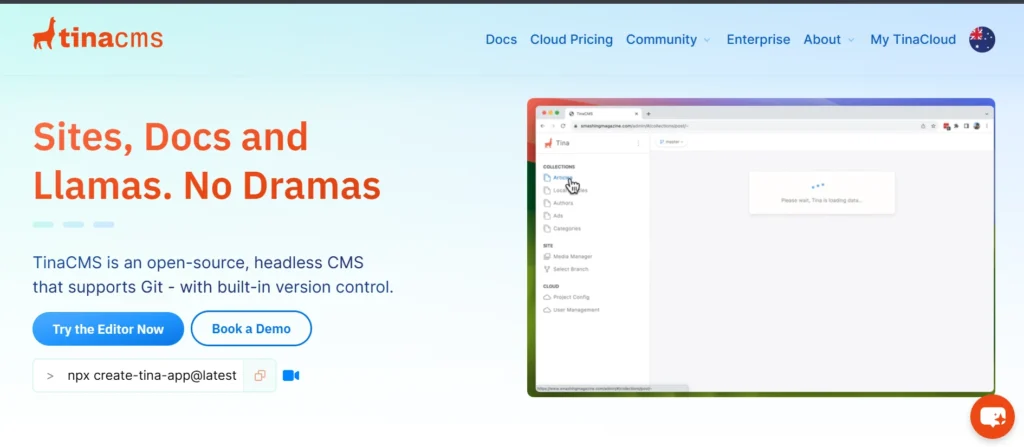
Website: https://tina.io/
TinaCMS is a custom open-source CMS built to operate within your Next.js project – it is a visually-editable Git-driven CMS. Unlike most headless CMSs, where the management typically is a separate product, TinaCMS is embedded in the frontend of your site. Editors are able to edit a sidebar with live previews, and their modifications are directed to your Git repo.
TinaCMS is ideal for those developers who need to deliver inline editing to the editors and keep the static site building speed and version control. It is entirely configurable; you can tell it about the content models, fields, and editing behavior to fit your project. It renders TinaCMS a very suitable choice for a marketing site, blog, or documentation that requires speed in rendering, teamwork, and is easy to maintain.
Top Features:
- Inline visual editing in the frontend
- Git-backed content management
- Customizable content models and UI
- Live preview for static sites
- Works seamlessly with Next.js static and ISR
Pricing:
| Free | Team | Team+ | Business | Enterprise |
| $0 | $24/mo | $41/mo | $249/mo | Custom |
14. Directus
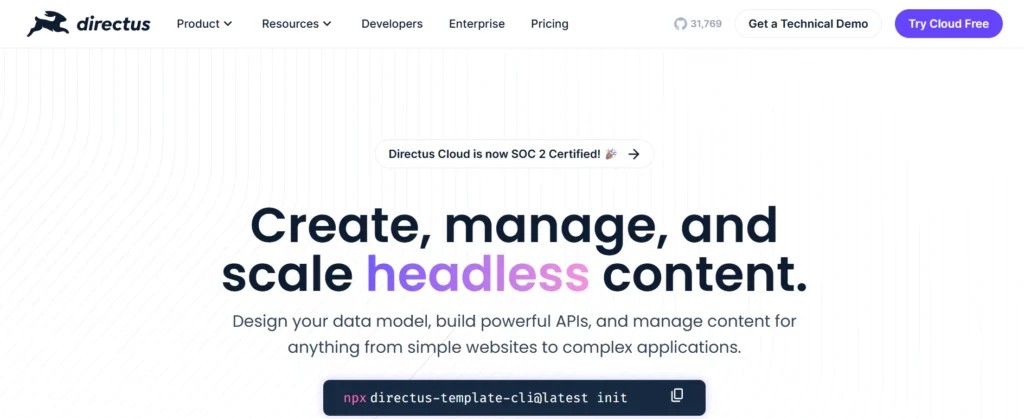
Website: https://directus.io/
Directus is an open-source data platform that turns any SQL database into a headless CMS, which makes it highly flexible for custom Next.js projects. Instead of storing your content in a proprietary backend, Directus sits on top of your database, giving you full control over your data structure. This approach is perfect for developers who want the benefits of a modern CMS while maintaining ownership of their database.
With Directus, you get a clean, intuitive admin app that lets non-technical users manage content easily. Its powerful API layer (REST and GraphQL) works great with Next.js for building static or dynamic sites. Directus is popular for projects that need complex relational data structures, like SaaS dashboards, multi-user apps, or content-driven sites that require robust permissions and workflows.
Top Features:
- Headless CMS for SQL databases
- REST and GraphQL API
- Highly customizable data models
- Roles, permissions, and workflows
- Open-source with cloud and self-hosted options
Pricing:
- Available on request
15. Kentico Kontent
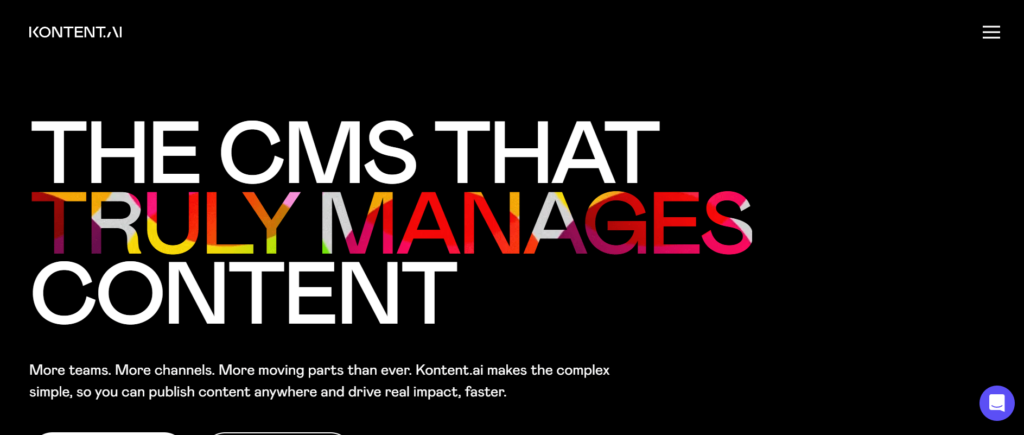
Website: https://kontent.ai/
Kentico Kontent is an enterprise-grade headless CMS that gives you the scalability and governance needed for large websites and digital experiences. Its cloud-first approach means content editors, marketers, and developers can collaborate without worrying about hosting or infrastructure. For Next.js teams, Kentico Kontent provides flexible APIs and SDKs that let you build static, server-rendered, or hybrid sites.
Strong collaboration and workflow tools, including role-based permissions, content versioning, and approval procedures, all intended for large teams handling intricate content structures, are among Kentico Kontent’s advantages. Its global CDN, multi-language support, and personalization tools help you deliver content quickly and effectively to audiences worldwide. Many large brands rely on Kentico Kontent for its stability, security, and enterprise-level support.
Top Features:
- Enterprise-ready headless CMS
- Rich APIs and SDKs for Next.js
- Strong workflows and governance
- Global CDN for fast delivery
- Multi-language and personalization support
Pricing:
- Pricing: Custom
Conclusion
In conclusion, picking the right CMSs for your Next.js project can make a big difference in how fast your website runs and how easily your team works. These CMSs enable you to manage content without holding down your developers, whether you’re building a major corporation website or a basic blog.
Selecting a CMS that is adaptable, quick, and simple to use will help you remain ahead of the curve and maintain optimal site performance as more websites become headless in 2025.
FAQs
Q. Do I need coding skills to use a headless CMS?
Most headless CMSs are designed for both developers and content editors. Developers handle the setup and integration, but editors can easily update text, images, and pages through a user-friendly dashboard — no coding needed.
Q. Is it safe to store all my website content in the cloud?
Yes. Most modern CMS providers use strong security measures like encryption, backups, and global servers to keep your data safe. Many also have role-based permissions to control who can edit or publish content.
Q. Can I switch my CMS later if I outgrow it?
One big benefit of using a headless CMS is flexibility. Because your content is separate from your site’s design, you can change your frontend framework or switch CMSs more easily without rebuilding everything from scratch.
Q. What makes a CMS a good match for Next.js?
A good CMS for Next.js should offer robust APIs (REST or GraphQL), support for static and dynamic content delivery, and work well with features like Incremental Static Regeneration (ISR). Tools with flexible content models and CDN-backed performance are especially ideal.
Q. Why choose a headless CMS over a traditional CMS for Next.js?
Headless CMSs give you more control over the frontend, enabling faster load times, better SEO, and omnichannel delivery. They decouple content from design, making them perfect for the flexibility and performance benefits Next.js offers.
